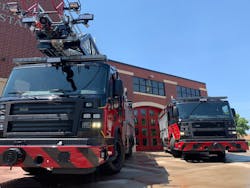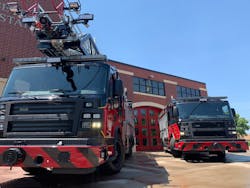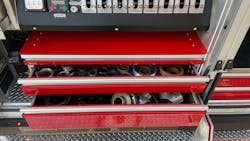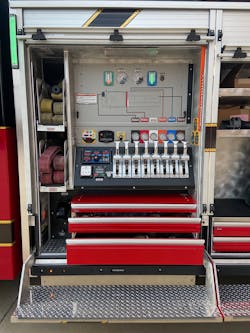Low bid. These two words can, for some, be the beginning of a purchasing process that’s filled with frustration and disappointment, given the many variables that are involved in apparatus procurement.
I often am asked whether there is another way to procure fire apparatus without having to simply use “low bid.” It wasn’t until the last 5–10 years that the answer became a resounding and successful, “Yes,” to those who seek a low-bid purchasing alternative by utilizing consortium purchasing processes.
Whether referred to as a “best-value,” “consortium” or “cooperative” purchasing process, the end-goal is the same: for the fire department or purchaser to receive the best-quality apparatus, specified and designed exactly as the customer needs, for the best possible price that’s available without using the standard public and low-bid response process. This all sounds like a wonderful idea, but how does it work, and how can you use it to your advantage?
Step one
The first step to a successful consortium purchasing process is to find out what options are available in your state for purchasing outside of using a low-bid process. Here are three cooperative, or consortium, purchasing solutions that are available. However, there are numerous others, so this isn’t an exhaustive listing:
- Sourcewell (formerly NJPA)— sourcewell-mn.gov
- HGACBuy— hgacbuy.org
- NASPO ValuePoint— naspovaluepoint.org
It always is important to check with your state and local officials for any laws that pertain to the use of purchasing consortiums to assure that you remain compliant throughout the buying process. Each consortium has a different process for how to purchase through its system. Some require membership, and some have fees that are associated with the membership. It is important to check with each consortium group, as well as with your department/city purchasing agent, because you already might be a member of one of these groups. It is common for municipalities to use these consortium purchasing programs for other large equipment items, such as dump trucks and construction equipment.
Several fire apparatus dealers throughout the country have seen their business transition to more than half of their sales resulting from consortium methods. This lends strong support to the process and the value that it provides to fire departments that acquire new apparatus. This also has provided benefits to the dealerships for how they structure sales support staff and how they focus their time.
Although this article doesn’t discuss the individual department needs assessment process, the process is an important part of any buying situation. A full understanding of what you want and need helps you to better leverage your purchasing power, particularly when you utilize consortium purchasing methods.
Step two
After you decide through which consortium you will purchase, you can reach out to the manufacturers from which you want to receive a proposal. That said, some customers simply solicit a single proposal from one original equipment manufacturer (OEM)/dealer, so they can purchase an apparatus that’s consistent with their current fleet and needs of the department. Although this certainly is a viable option, working with more than one apparatus manufacturer (or dealer) helps to assure that you get the best value for your purchase while meeting your exact needs.
These changes to the purchasing process are altering the way that the traditional apparatus purchasing market operates. Fire apparatus dealers spend more time working one-on-one with fire departments to meet their exact needs prior to a formal price proposal and less time reading hundreds of pages of published specification documents and submitting price proposals with little or no contact with the customer. The days of random bidding are changing. This reduces frustration on both ends of the sale. The dealer sales staff doesn’t feel like they are “chasing” their tails on dead-end project proposals, and the customer reduces the amount of time, effort and money that is put into an acquisition process by not having to read through noncompliant “low-ball” bids.
Step three
After you select the OEM that you want to work with and contact its dealer, notify them that you will purchase through a consortium purchasing authority. They then can provide you with the base models that they have listed with the specific consortium for the type of apparatus that you’re buying (aerial, engine, rescue, etc.).
Once you decide on a base model with the OEM/dealer, you can discuss which options you need, what modifications need to be made to the proposed apparatus and what the changes/additions will cost. It is important to note that, just because you use a consortium purchasing process, you don’t have to purchase a watered-down, no-options apparatus that won’t meet your department’s needs. This transitions the apparatus buying process into a more open and transparent process that gives the customer the chance to evaluate a specific design feature and its cost before including it in a purchase.
The consortium process is similar to purchasing a new car; you see all of the available options and how much they cost before you ever include them in your purchase, rather than trying to decipher hundreds of pages of complicated proposals with little or no understanding of how much a particular request in a specification might cost the department.
Other considerations
Although fire departments generally serve a similar mission, all are unique in how they respond and the tools and equipment that their apparatus need to have on them. These unique requirements translate into high cost when purchasing an apparatus, as every special or custom option that’s added to a project increases the price because of extra engineering and production time. The more customization that’s needed, the higher the end price. An open dialogue about specific customer needs with a dealer allows the OEM/dealer to provide valuable feedback on what options exist to meet the customer needs while avoiding the high costs that are associated with custom one-off solutions from a manufacturer.
Keep in mind, the industry produces thousands of apparatus per year, and each manufacturer has a large catalog of available, already-made solutions that solve aIn addition to the design needs of the department, you also can include feedback and requests from your maintenance departments. Some maintenance staff might have requests for using specific types of materials or locating commonly serviced options in easier-to-access locations. These types of requests can be discussed with the OEM/dealer for incorporation into your proposal, which helps to reduce long-term maintenance costs of your new purchase.
Another of the key benefits of the consortium process is that you can have these open dialogues with more than one OEM/dealer. This allows you to truly understand a final price proposal and assures that the finite details of your needs are represented in the proposal. This open dialogue allows the customer to receive updated drawings of the final apparatus and/or photographs of specific components to make sure that the end result is as desired. Through this process, some manufacturers even provide 3D drawings of components, to help a customer to better visualize a solution before a purchase is made and any metal is cut.
The consortium process allows you to work with your dealer(s) to determine a comprehensive apparatus configuration that meets your department’s needs and that assures you that you are within your budget parameters. This will give you confidence that your new apparatus will meet the operational needs of your department when it arrives. Through the detailed consortium process, you will be able to take a proposal to your purchasing-approving authority (city council, fire board, etc.) and articulate your research and the cost/benefit of the various options that you included in your project, to ensure that your new apparatus meets the needs of your community today and tomorrow.
About the author
Neil Sjostrom has been in the fire service for 15 years and currently is a career battalion chief for the Roseville, MN, Fire Department. He also has spent more than 10 years working in the fire apparatus industry, both for OEMs and apparatus dealers, in inside and outside sales positions.
About the Author

Neil Sjostrom
Neil Sjostrom is the assistant fire chief of the Roseville, MN, Fire Department. He previously served as a firefighter, lieutenant and battalion chief during his 19 years with the department. Sjostrom also serves as therapy/service K9 program coordinator and handler as part of the Therapy Comfort Canine program. He holds a bachelor’s degree in criminal justice from Metropolitan State University.




